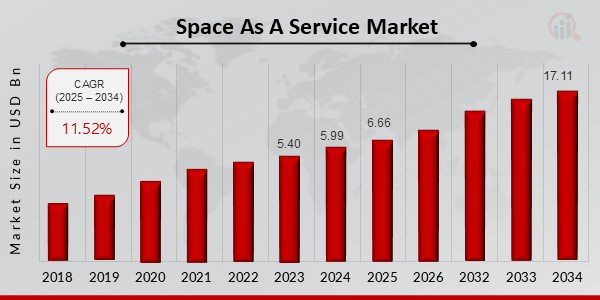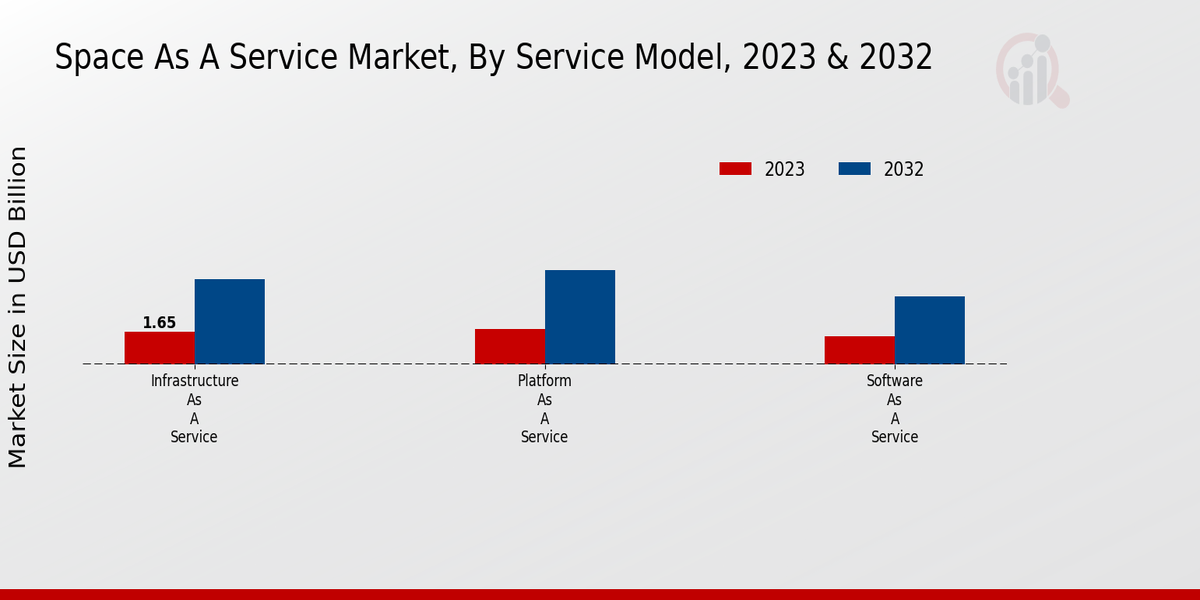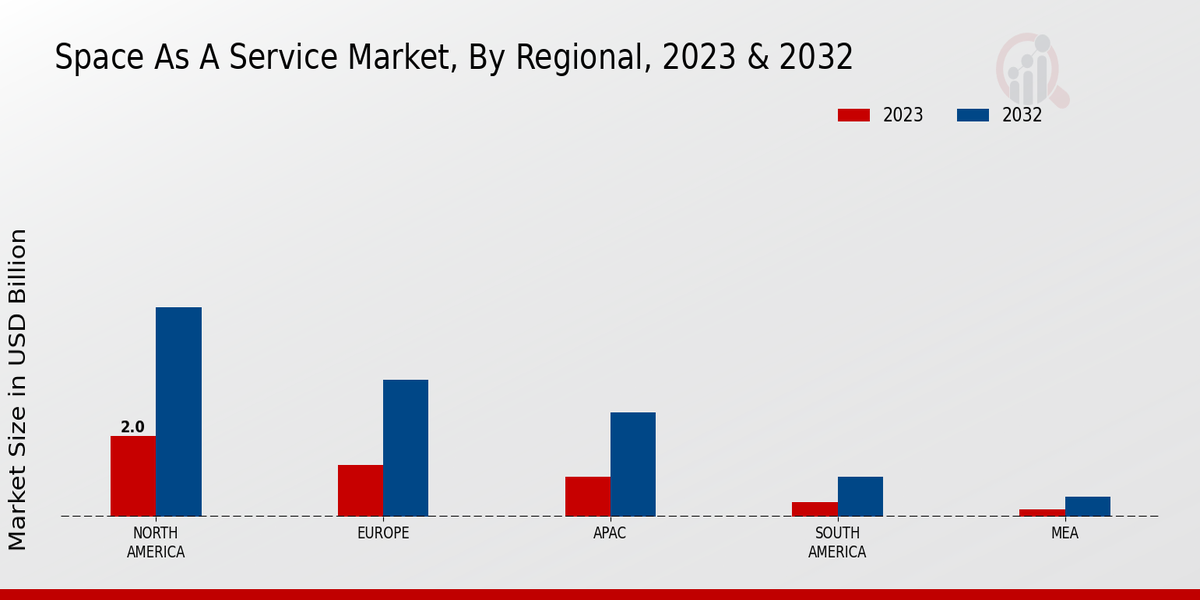Space as a Service Market Overview
Space As A Service Market is projected to grow from USD 6.66 Billion in 2025 to USD 17.11 Billion by 2034, exhibiting a compound annual growth rate (CAGR) of 11.52% during the forecast period (2025 - 2034). Additionally, the market size for Space As A Service Market was valued at USD 5.99 billion in 2024.
Key Space as a Service Market Trends Highlighted
The Space as a Service Market is witnessing significant growth driven by the increasing demand for satellite-based services and the rise of private sector involvement in space exploration. As advancements in technology lower barriers to entry, more businesses are looking to leverage space assets for a variety of applications, including telecommunications, earth observation, and data analytics. This trend is further supported by government initiatives promoting space activities, leading to enhanced collaboration between public and private sectors.
The growing recognition of space as a critical resource for addressing challenges, such as climate change and disaster management, also acts as a catalyst for market expansion.
In recent times, key opportunities lie in the commercial utilization of low Earth orbit (LEO) and the development of small satellite technologies. As more companies aim to establish a presence in LEO, opportunities arise for various applications, including Internet of Things (IoT) connectivity and enhanced communications. The increase in space applications is pushing the industry towards more integrated service offerings, where end-to-end solutions are developed to meet diverse customer needs. Additionally, as international space policies evolve, there is potential for more investments and partnerships that promote innovation in space-based technologies.
Current trends indicate a shift toward sustainability and the reclamation of orbital space. The focus on minimizing space debris is gaining traction, prompting new technologies aimed at debris removal and sustainable satellite design. Moreover, partnerships between commercial entities and governmental agencies are becoming more common as they pursue shared goals in space exploration. The overall landscape is quickly changing as innovation meets practical needs, making space more accessible to a broader range of organizations and governments. These developments present a dynamic and promising environment for future growth in the Space as a Service Market.
Fig 1: Space as a Service Market Overview

Source: Primary Research, Secondary Research, Market Research Future Database and Analyst Review
Space as a Service Market Drivers
Increasing Demand for Cost-Effective Solutions
The Space as a Service Market industry is witnessing a robust surge in demand for cost-effective space solutions driven by both the public and private sectors. Organizations are increasingly opting for these services as they allow them to optimize their operational costs without compromising on quality. This trend is primarily influenced by the need for flexibility in space management, which traditional real estate does not offer. Businesses can significantly reduce upfront capital expenditure by leveraging Space as a Service models, which include flexible leasing and on-demand services tailored to unique requirements.
Such models enable clients to scale their operations efficiently, thus focusing their financial and human resources on core business functions instead of being tied down by real estate issues. This paradigm shift is essential for emerging companies and startups looking to optimize their cash flow and gain a competitive edge in the market. The proliferation of remote work solutions further amplifies the dynamics, necessitating more adaptable office space configurations. Consequently, as more enterprises recognize the advantages of flexible workspace solutions, the Space as a Service Market is expected to flourish, capturing a larger share of the sector.
Technological Advancements Enhancing Service Offerings
Technological advancements play a vital role in propelling the Space as a Service Market industry forward. Innovations such as artificial intelligence, the Internet of Things (IoT), and advanced data analytics are making it easier for service providers to manage and optimize spaces in real time. These technologies enable better insights into space utilization, allowing companies to tailor their offerings according to client needs. As a result, customers benefit from enhanced experiences, improved energy efficiency, and better resource allocation.
Furthermore, the trend towards smart buildings is also expected to complement the growth of the market as businesses strive to create environments that not only support productivity but also ensure sustainability.
Growing Preference for Flexible Workspaces
The growing preference for flexible workspaces is a significant driving force in the Space as a Service Market industry. With unprecedented shifts in work culture, especially following recent events, many companies are rethinking traditional office spaces. The need for adaptable work environments that can evolve with changing organizational dynamics is more critical than ever. Companies now prefer solutions that offer modular and movable workspaces to accommodate both full-time employees and freelancers.As remote work becomes a norm, the demand for flexible workspace solutions provides businesses with more agility and cost savings, fueling the expansion of the market.
Space as a Service Market Segment Insights
Space as a Service Market Service Model Insights
The Space as a Service Market is currently witnessing notable growth within its Service Model segment, which encompasses various categories such as Infrastructure as a Service, Platform as a Service, and Software as a Service. In 2023, the overall market was valued at 4.87 USD Billion and is projected to reach 12.5 USD Billion by 2032. This reflects the robust trajectory of market growth driven by rising demand for flexible, cost-effective space solutions.
Among these categories, Infrastructure as a Service holds a significant position with a valuation of 1.65 USD Billion in 2023 and is expected to reach 4.31 USD Billion in 2032. This segment's dominance is largely due to its capability to provide vital infrastructure resources without the need for physical hardware, making it an attractive choice for businesses looking to optimize operational costs and enhance scalability. Platform as a Service follows closely, being valued at 1.8 USD Billion in 2023 and expected to rise to 4.75 USD Billion by 2032.
Its importance is underscored by the increasing need for application development frameworks and testing environments, allowing organizations to innovate swiftly without the overhead of hardware management. Software as a Service, while holding the smallest share among the three, with a valuation of 1.42 USD Billion in 2023 and anticipated growth to 3.44 USD Billion in 2032, remains a critical component as it enables users to access software applications via the cloud. The accessibility and convenience it provides are essential factors driving its steady growth.
The overall dynamics of the Space as a Service Market segmentation illustrate a trend toward greater adoption of cloud-based solutions across multiple sectors. This segment's expansion is motivated by increasing digital transformation initiatives and a growing reliance on sustainable practices to reduce costs and optimize resource utilization. Challenges such as data security and integration with existing systems do exist; however, the opportunities presented by the move towards remote work, flexible business operations, and the scaling of digital platforms are substantial.
As the market evolves, each category within the Service Model segment is uniquely positioned to capitalize on the industry's changing landscape, contributing to the overall growth narrative of the Space as a Service Market.
Fig 2: Space as a Service Market Insights

Source: Primary Research, Secondary Research, Market Research Future Database and Analyst Review
Space as a Service Market Application Insights
The Space as a Service Market, focusing on the Application segment, is poised for notable growth with significant contributions from various areas, including Satellite Operations, Launch Services, and Data Analytics. In 2023, this market was valued at 4.87 billion USD, reflecting the increasing demand for satellite capabilities and infrastructure. Satellite Operations play a crucial role, as they offer continuous monitoring and management services essential for a wide range of applications, from environmental monitoring to communication enhancements.
Launch Services are also integral, facilitating the timely deployment of satellites into orbit, which is critical for both commercial ventures and governmental missions. Data Analytics further amplifies the market's potential by transforming vast amounts of space-generated data into actionable insights, driving decision-making processes across multiple sectors. Such segmentation highlights the diverse nature of the Space as a Service Market, underscoring its wide-ranging applications and the growing reliance on space technologies across industries.
The expected market growth is fueled by advancements in technology and an increasing reliance on space data, which provide ample opportunities for innovation and investment within this dynamic industry.
Space as a Service Market End Users Insights
The Space as a Service Market, valued at 4.87 billion USD in 2023, illustrates a robust landscape among its End Users, which primarily includes Government, Commercial, and Research Institutions. Government applications take precedence as they leverage space services for national defense, climate monitoring, and disaster management, fostering growth in this sector. Meanwhile, the Commercial segment thrives on opportunities presented by satellite services, data analytics, and connectivity solutions. This area has seen a rapid increase in demand as businesses seek innovative solutions to enhance operational efficiency.
Research Institutions play a pivotal role in advancing space technologies through collaborative projects and scientific endeavors. Collectively, these End Users contribute to the Space as a Service Market Revenue by driving innovations that align with their specific needs. The industry is characterized by increasing investments in space technologies, urging all segments to broaden their capabilities and enhance service offerings, positioning the market for significant growth. Overall, the Space as a Service Market data highlights these dynamic segments as crucial drivers in the ongoing evolution of space service utilization.
Space as a Service Market Deployment Type Insights
In 2023, the Space as a Service Market is projected to reach a valuation of 4.87 billion USD, showcasing a favorable landscape for various deployment types. This segment can be primarily categorized into Cloud-based, On-premise, and Hybrid options. Among these, the Cloud-based deployment has gained substantial traction owing to its flexibility and cost-effectiveness, allowing businesses to scale operations efficiently without extensive upfront investments.
On-premise solutions, while traditionally seen as secure, are experiencing slower growth as companies shift towards more agile and remote competence.The Hybrid model is emerging as a significant player, combining the benefits of both Cloud-based and On-premise deployments, thus catering to organizations with specific data management or compliance needs. Overall, the Space as a Service Market segmentation reveals a dynamic environment spurred by increasing demand for efficient, scalable, and flexible solutions, ensuring that each deployment type plays a crucial role in meeting diverse business requirements. The market is poised for expansion, driven by technological advancements and evolving consumer preferences.
Space as a Service Market Regional Insights
The Space as a Service Market revenue reached 4.87 USD Billion in 2023 and is projected to grow significantly across various regions. North America emerges as a dominant force in this market, valued at 2.0 USD Billion in 2023 and expected to climb to 5.2 USD Billion by 2032, reflecting its majority holding driven by robust technological advancements and government investments. Europe follows with a notable valuation of 1.3 USD Billion in 2023, advancing to 3.4 USD Billion in 2032, showcasing its strong commitment to space exploration and research initiatives.
The APAC region is witnessing rapid growth, starting at 1.0 USD Billion in 2023 and expanding to 2.6 USD Billion by 2032, fueled by increasing private sector involvement in space ventures. South America and MEA are comparatively smaller markets, valued at 0.37 USD Billion and 0.2 USD Billion, respectively, in 2023, with projections of reaching 1.0 USD Billion and 0.5 USD Billion by 2032. These regions represent accessible opportunities, although they currently hold less market share.
Overall, the Space as a Service Market segmentation highlights the pivotal role of North America and Europe while also acknowledging the growth potential in other regions, driven by emerging players and innovations.
Fig 3: Space as a Service Market Regional Insights

Source: Primary Research, Secondary Research, Market Research Future Database and Analyst Review
Space as a Service Market Key Players and Competitive Insights
The Space as a Service Market is experiencing significant growth as enterprises seek flexible, scalable, and cost-effective solutions for managing their spatial resources. This market encompasses a range of services, including data storage, virtual office space, and IT infrastructure management, allowing organizations to optimize their operations while minimizing overhead costs. Competitive insights reveal a landscape characterized by intense rivalry among key players who are expanding their offerings through innovation and strategic partnerships. This dynamic environment is fueled by the increasing demand for digital transformation as businesses increasingly rely on cloud-based solutions to enhance efficiency and agility.
As organizations transition away from traditional, fixed workspace models, the competitive strategies employed by market leaders are becoming critical in securing a strong foothold and driving sustainable growth. Microsoft stands out in the Space as a Service Market with its expansive cloud capabilities and enterprise-grade solutions.
The company's Azure platform provides a comprehensive suite of services that enable businesses to deploy, manage, and scale applications and infrastructure seamlessly. Microsoft's strengths lie in its strong brand recognition, extensive research and development investments, and innovative product offerings that cater to a diverse clientele. The company fosters a significant ecosystem of partners, contributing to a robust marketplace where additional services can be seamlessly integrated. Moreover, Microsoft’s commitment to security and compliance features instills trust in customers, which is critical for organizations handling sensitive data in shared environments.
This strategic focus ensures that Microsoft maintains a competitive edge in the rapidly evolving Space as a Service landscape.
Hewlett Packard Enterprise (HPE) promotes its unique approach to the Space as a Service Market through its hybrid cloud solutions and flexible consumption models. HPE's offerings are designed to empower organizations by providing a seamless transition to cloud environments while ensuring that they maintain control over their on-premises resources. The strength of HPE lies in its ability to deliver tailored solutions that meet specific business needs, leveraging advanced technologies such as edge computing and artificial intelligence. HPE’s strong partnerships with other technology providers enhance its service portfolio, creating comprehensive solutions that further solidify its market presence.
Additionally, the company's focus on sustainability and energy-efficient practices resonates well with modern enterprises looking to minimize their environmental impact while optimizing their resource utilization. This alignment with current market demands positions HPE favorably against competitors in the Space as a Service Market.
Key Companies in the Space as a Service Market Include
Space as a Service Market Industry Developments
The Space as a Service Market has seen significant recent developments, with major players like Microsoft, Amazon Web Services, and IBM expanding their service offerings to include enhanced satellite data analytics and cloud integration. Companies such as SpaceX and Rocket Lab are actively launching new satellites to bolster their service portfolios, while Northrop Grumman and Boeing are enhancing their contributions to space-based systems integration. Notable mergers and acquisitions have taken place, such as Oracle's strategic partnerships with satellite technology firms to enhance data services and Hewlett Packard Enterprise's focus on increasing cloud capabilities through acquisitions in the analytics domain.
The increasing valuation of these companies reflects an emerging trend toward collaboration in space technology, ultimately leading to enhanced capabilities for clients across industries. Furthermore, firms like DigitalGlobe and Airbus are innovating in Earth observation and data management, which significantly influences the market's growth trajectory. The continual investment in both infrastructure and technology advancements indicates a strong commitment by these organizations to meet the rising demand for space-related services, thus reshaping the landscape of the Space as a Service Market.
Space as a Service Market Segmentation Insights
Space as a Service Market Service Model Outlook
- Infrastructure as a Service
Space as a Service Market Application Outlook
Space as a Service Market End Users Outlook
Space as a Service Market Deployment Type Outlook
Space as a Service Market Regional Outlook
|
Report Attribute/Metric
|
Details
|
|
Market Size 2024
|
5.99 (USD Billion)
|
|
Market Size 2025
|
6.66 (USD Billion)
|
|
Market Size 2034
|
17.11 (USD Billion)
|
|
Compound Annual Growth Rate (CAGR)
|
11.52% (2025 - 2034)
|
|
Report Coverage
|
Revenue Forecast, Competitive Landscape, Growth Factors, and Trends
|
|
Base Year
|
2024
|
|
Market Forecast Period
|
2025 - 2034
|
|
Historical Data
|
2019 - 2023
|
|
Market Forecast Units
|
USD Billion
|
| Key Companies Profiled |
Microsoft, Hewlett Packard Enterprise, Amazon Web Services, Oracle, SpaceX, Lockheed Martin, Airbus, Rocket Lab, IBM, Northrop Grumman, DigitalGlobe, IBM Technology Services, Boeing, Google Cloud, Viasat |
| Segments Covered |
Service Model, Application, End Users, Deployment Type, Regional |
| Key Market Opportunities |
Increased satellite launch demands, Expanding small satellite market, Cost reduction in space access, Growth in satellite data analytics, Advancements in CubeSat technology |
| Key Market Dynamics |
Increasing demand for flexibility, Cost-effective solutions, Technological advancements in space, Growing commercial space exploration, Enhanced collaboration |
| Countries Covered |
North America, Europe, APAC, South America, MEA |
Frequently Asked Questions (FAQ):
The Space as a Service Market is expected to be valued at 17.11 USD Billion by 2034.
The projected CAGR for the Space as a Service Market from 2025 to 2034 is 11.52%.
North America holds the largest market share in the Space as a Service Market.
The market value of the Space as a Service Market in North America is expected to be 5.2 USD Billion in 2032.
Key players in the Space as a Service Market include Microsoft, Amazon Web Services, and SpaceX.
Infrastructure as a Service is expected to reach a market size of 4.31 USD Billion by 2032.
The Space as a Service Market is valued at 1.3 USD Billion in Europe for the year 2023.
The expected market value of Software as a Service by 2032 is 3.44 USD Billion.
The anticipated market size in the Asia-Pacific region is projected to be 2.6 USD Billion by 2032.
The Software as a Service segment is expected to grow significantly, reaching a value of 3.44 USD Billion by 2032.

















